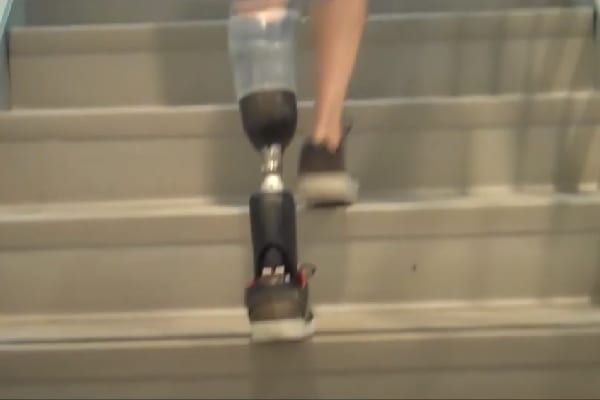Everything you need to know about bionic legs, knees, ankles, and feet. Continuously updated, this page is your one-stop repository for all the latest information on lower-limb devices, technologies, and research.
What’s On This Page?
- What is a Bionic Leg?
- Understanding the Technical Challenges for Bionic Legs
- Surgical Procedures
- Current Bionic Ankles & Feet
- Current Bionic Knees
- Current Full Bionic Legs
- Open Source Bionic Legs & Feet
- Latest Research Articles
- User Satisfaction Reports
- Bionic Feats
- Real Stories
- Related Information
What is a Bionic Leg?
A bionic leg is an electromechanical device that attaches to the human body via a socket and attempts to replicate the functionality of a natural leg.
It always consists of sensors, a microprocessor ankle/foot or knee, and at least one battery.
Some devices, such as Blatchford’s Linx bionic leg, have all of these components:

Understanding the Technical Challenges for Bionic Legs
The Basic Mechanics of Walking
When humans walk, each leg alternates between a Stance phase (the foot has contact with the ground) and a Swing phase (the foot is off the ground). These phases can be divided into sub-phases:

Source: https://www.researchgate.net/figure/Human-gait-cycle-28_fig1_324346331
During this gait cycle, the body employs several biomechanical functions including:
- shock absorption by muscles, tendons, ligaments, and cartilage from the moment of Heel Strike until the full body weight is assumed by the Stance leg;
- antagonistic muscle pairs to move the foot, ankle, knee, and hip into the desired positions;
- the use of elastic energy as tendons and muscles stretch during the first half of the Stance phase, then recoil to help begin the Swing Phase;
- muscle contraction to lift each leg and propel the body forward.
Most of these functions have mechanical equivalents such as dampers, springs, actuators, etc. The challenge is controlling and coordinating them in a smooth, integrated manner.
Bionic Leg Control Systems

When we humans approach an obstacle like stairs, we glance at them to gauge their height, steepness, tread width, etc. To climb the stairs with natural legs, we automatically adjust our stride, foot placement, joint angles, and muscle power. This is possible because of our brain’s ability to:
- perceive a 3D map of its surroundings including the terrain;
- use proprioception to maintain a keen sense of our body’s position within that 3D map;
- precisely adjust and control the movements of hundreds of muscles.
The bionic legs and feet currently on the market do not attempt to replicate this sophisticated system (though the new Agonist-antagonist Myoneural Interface (AMI) technology may help close the gap). Instead, their sensors gather information like walking speed, joint angles, etc. Microprocessors then use this data to automatically adjust settings such as joint resistance, sometimes hundreds or even thousands of times per second.
These systems are localized, reactive, and completely independent from the human brain. Yet, they have proven to be remarkably successful, as shown in this short video of a double amputee walking and running up a set of stairs:
Still, users want more. They want improved user control over their bionic limbs, sensory feedback, and even power-assisted propulsion.
To learn the status of many of these objectives, please see our full article on control systems for bionic legs and feet.
Surgical Procedures
For thousands of years, amputations served only one purpose: to sever a damaged or diseased limb. Little thought was given to preparing the residual limb for an eventual prosthesis.
This situation has changed dramatically over the past two decades. Surgeons now have procedures to:
- reassign severed nerves for reduced limb pain and improved muscle control in the residual limb;
- reconnect severed muscle pairings to restore proprioception;
- implant myoelectric sensors to improve the detection and interpretation of muscle movements;
- attach electrodes to nerve bundles to facilitate sensory feedback;
- insert a metal rod in one of the major leg bones to act as a superior prosthetic connector and eliminate the need for a socket;
Indeed, these procedures have advanced to the point where they should now be considered by new and existing amputees alike. To learn more, see Surgical Techniques That Improve the Use of Bionic Limbs.
Current Bionic Ankles/Feet
Bionic ankles/feet are responsible for the following tasks:
- automatically adjusting the resistance in the ankle to ensure the proper level of support through each stage of the Stance Phase regardless of terrain;
- keeping the foot “toes” up during the Swing Phase to create more clearance and reduce the risk of tripping;
- some bionic ankles also actively manage the ankle rotation (i.e. foot angle) based on terrain, and one (the Empower Ankle) provides added propulsive power.
The main bionic ankles/feet currently on the market are:
- Elan from Blatchford
- Elan IC from Blatchford
- Empower from Ottobock
- Freedom Kinnex from Proteor USA
- Meridium from Ottobock
- Proprio from Ossur
- Raize from Fillauer
This promotional video from Blatchford provides an excellent technical description of the end-user benefits from such devices, starting at 1:10:
Unfortunately, it is difficult to find independent, first-hand consumer reviews of bionic ankles/feet, though we have begun to add a few of these to our device articles. Most material on the subject is still either promotional or scientific.
Until that situation changes, we’ll settle for showing the latest advances such as this bionic ankle/foot for more active amputees:
Bionic Ankles/Feet Affordability
Based mainly on user feedback, most bionic ankles/feet sell for between $18,000 to $25,000 US. This makes sense given that the Medicare/Medicaid reimbursement rates are around $18,000 US for this type of device.
The most expensive bionic ankle/foot is Ottobock’s Empower Ankle, which sells for between $40,000 to $50,000 US. That’s quite a leap in price, but if you watch our videos on the Empower, it’s also quite a leap in technology.
For more information, see our Bionic Foot Price List.
Current Bionic Knees
Bionic knees are responsible for the following tasks:
- automatically adjusting the resistance in the knee to ensure the proper level of support through each stage of the Stance Phase regardless of terrain;
- ensuring the optimal release point for the knee to begin the Swing Phase and the proper knee extension/damping at the end of this phase;
- assisting in stumble recovery.
The main bionic knees currently on the market are:
- Allux from Nabtesco/Proteor
- C-Leg from Ottobock
- Freedom Plie Knee from Proteor
- Freedom Quattro Knee from Proteor
- Genium from Ottobock
- Genium X3 from Ottobock
- IntelLeg from Reboocon
- Kenevo from Ottobock
- Orion from Blatchford
- Power Knee from Ossur
- Rheo from Ossur
- Rheo XC from Ossur
- V-One from Teh Lin
Again, it is difficult to find independent, first-hand consumer reviews of bionic knees. But this video of a young man using one of the most advanced knees — Ottobock’s Genium X3 — at least provides a glimpse of their potential:
Paired with the correct prosthetic foot, there are obviously few limits on the use of this knee. So, with a knee like this, why would someone need a bionic ankle? First, using the knee alone is more tiring without the assistance of a bionic ankle. It also isn’t as smooth when walking up or down stairs or other inclines.
This of course leads to the question: what happens when you combine these two technologies? We answer this question below.
Bionic Knees Affordability
Based mainly on user feedback, most bionic knees sell for between $20,000 to $50,000 US.
The most expensive bionic knee is Ottobock’s Genium X3, which can cost more than $100,000 US depending on the prosthetic foot that is paired with it, warranty extensions, etc.
For more information, see our Bionic Knee Price List.
Current Full Bionic Legs
There is only one bionic leg we know about that fully integrates a bionic knee and ankle. This is Blatchford’s Linx:
It is inspiring to see amputees being so physically active. It’s proof that, technically, we are getting close to eliminating lower-limb disabilities.
The problem is one of availability. This is limited not only by price but also by insurance policies.
For example, Ossur combined its Rheo bionic knee with its Proprio bionic ankle to create a Symbionic leg product but the resulting product had poor sales. Why? Because public and private medical insurance resisted paying for it.
Bionic Leg Affordability
The Linx sells for between $60,000 and $70,000 including the socket and all prosthetist fees.
Open-Source Bionic Legs & Feet
For decades now, the open-source approach has flourished in the software industry. It works by allowing the entire user community to contribute to software solutions. It speeds up innovation, reduces costs, and fosters standardization. Just on the issue of standardization alone, this makes software more modular and easier to reuse.
Now compare this to the world of bionic legs & feet. Even though the tasks faced by one bionic limb manufacturer are quite similar to those faced by another, many take a proprietary approach. This has the unfortunate effect of slowing progress and making end products more expensive.
Fortunately, the University of Michigan is spearheading an Open-Source Bionic Leg initiative.
The objectives for this program are not yet as far-reaching as a typical open software initiative, as it is focused more on standardizing aspects of the R & D process. But the benefits of this approach will ultimately trickle down into the commercial market.
Latest Research Articles for Bionic Legs / Feet

Surgical Techniques That Improve the Use of Bionic Limbs
This document helps amputees monitor all current and future surgical techniques that may improve the use of bionic limbs and/or reduce pain.

Bionic Leg & Foot Control Systems
The current control systems for bionic legs & feet are mostly autonomous, but researchers are actively exploring direct control and sensory feedback.

Magnetomicrometry (MM) for Bionic Limb Control
Users will not be satisfied until they have precise, intuitive control over bionic limbs. Magnetomicrometry may help fulfill this goal.

Agonist-antagonist Myoneural Interface (AMI)
A new surgical technique is improving the ability of end-users to sense the position and movement of bionic limbs, as well as reducing phantom pain.
User Satisfaction Reports for Bionic Legs / Feet

Bionic Limb User Satisfaction Statistics for 2021
Here is what our User Satisfaction Surveys have taught us about bionic limbs as of December 31, 2021.

Ottobock C-Leg User Satisfaction Report
The Ottobock C-Leg is the 2nd-highest-rated bionic knee in our User Satisfaction Surveys in both general user satisfaction and brand loyalty.

Bionic Limbs — First Impressions From Our User Satisfaction Surveys
Check out our early impressions from the results of our User Satisfaction Surveys on bionic limbs. Results for individual devices to follow.
Real Stories for Bionic Legs & Feet

Tom Allred’s Journey to the Blatchford Linx
In this article/interview, I talk with one bilateral above-the-knee amputee’s 60-year journey from wooden sockets to a pair of Blatchford Linx bionic limbs.

Bionic Feats: Conquering Stairs
A few decades ago, going up and down the stairs was an ordeal for lower-limb amputees, even dangerous. These five short videos show how bionic knees and ankles have made this important daily task so much easier!

The Power of Bionic Limbs to Change Lives
We are entering an era where bionic limbs will eliminate many of the disability aspects of having a limb difference. This post shows some early examples.

Bionic Feats: Challenging Terrain
As lower-limb bionic technologies improve, users naturally want to venture beyond “safe” surfaces and go wherever they want. Here are a few examples of this.

The Revolution in Prosthetic Aesthetics
There is something transformative happening in the prosthetics industry — a long-overdue awakening among product designers, those with limb differences, and the general public that is helping us take a big step toward a more inclusive society.
Related Information
For a comprehensive description of all current upper-limb technologies, devices, and research, see our complete guide.
